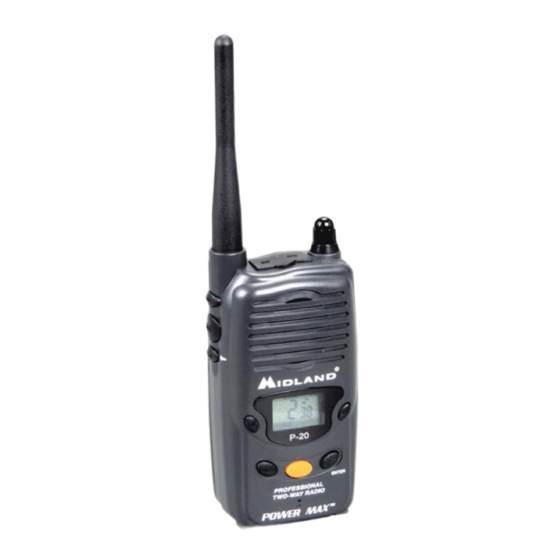
Summary of Contents for Midland P-20
- Page 1 Owner’s Manual for the P-20 (Itinerant Radio) Owner’s Manual for the P-20 Check out our accessories at www.midlandradio.com or click on the images http://www.midlandradio.com http://www.midlandradio.com Page 1 of 16...
-
Page 2: Table Of Contents
Owner’s Manual for the P-20 (Itinerant Radio) TIPS FOR GETTING THE MOST FROM YOUR P20 ... 3 A NOTE ABOUT THE CTCSS or DCS CODES ... 4 CHARGING THE BATTERIES... 5 BELT CLIP ... 5 QUICK USE INSTRUCTIONS: ... 5 RANGE OF UHF RADIOS ... -
Page 3: Tips For Getting The Most From Your P20
THE CONDITION THAT THIS DEVICE DOES NOT CAUSE HARMFUL INTERFERENCE. Your Midland model P20 UHF FM business two-way radio is designed to provide you with line-of- sight communications for a range up to 4 miles. The model P20 incorporates channels with 38 different CTCSS and 83 DCS codes to provide the best in quiet communications. -
Page 4: A Note About The Ctcss Or Dcs Codes
Owner’s Manual for the P-20 (Itinerant Radio) Your wireless hand-held portable transceiver contains a low power transmitter. When the Push-to-Talk (PTT) button is pressed it sends out radio frequency (RF) signals. The device is authorized to operate at a duty factor not to exceed 50%. In August 1996, the Federal Communications Commission (FCC) adopted RF exposure guidelines with safety levels for hand-held wireless devices. -
Page 5: Charging The Batteries
Owner’s Manual for the P-20 (Itinerant Radio) PREPARATION Batteries - P20 radios operate with 3 AA Alkaline, Ni-Cad (nickel cadmium) or Ni-MH (nickel metal hydride) batteries (optional). Ni-Cad batteries provide about 15 hours of use. Alkaline batteries will provide about 45 hours of use and Ni-MH batteries will provide about 24 hours of use. The P20 may be supplied with Ni-Cad or NI-MH batteries and a wall charger. -
Page 6: Range Of Uhf Radios
Owner’s Manual for the P-20 (Itinerant Radio) POWER SAVE CIRCUIT This part of the operation of the radio is completely automatic and not adjustable. When the radio has not transmitted or received a signal for several seconds it will begin to cycle from a sleep mode to fully on. -
Page 7: Features And Location Of Contols
Owner’s Manual for the P-20 (Itinerant Radio) FEATURES AND LOCATION OF CONTOLS 1 VOX button 2-Up/Down Buttons 5-Call Button 6-Accessory jacks 9-Function Button 10-charging contacts 11-Charge Jack THE RADIO MUST NOT BE SCANNING OR TRANSMITTING AND THE CONTOLS NOT LOCKED BEFORE THE CONTROLS WILL WORK PROPERLY. -
Page 8: Adjusting The Volume
Owner’s Manual for the P-20 (Itinerant Radio) You can have only two channels in the active mode at a time. If you try to activate more than two channels, the radio will beep two or three times. Check and turn off any other active channels and try again. -
Page 9: Activating Scan Functions
Owner’s Manual for the P-20 (Itinerant Radio) ACTIVATING SCAN FUNCTIONS The P20 has three scan modes. The most popular and most used is the “BUSY” channel scan. This allows the radio to stop on a channel that someone is talking on. -
Page 10: Dcs Codes
Owner’s Manual for the P-20 (Itinerant Radio) ACTIVATING “PRIVACY CODES” To activate “CTCSS” codes 1. Press the “F” button repeatedly (usually 3 times) to cause the icon “CTCSS” to be displayed in the upper left of the display to flash. -
Page 11: Resetting The Radio
Owner’s Manual for the P-20 (Itinerant Radio) RESETTING THE RADIO If the radio stops responding to button presses or otherwise does not function properly in some cases the radio can be reset to restore normal operation. To reset the radio: With the radio off, press and hold the “F” button and turn the radio on. -
Page 12: Setting Remote Monitor Mode
Owner’s Manual for the P-20 (Itinerant Radio) SETTING REMOTE MONITOR MODE 1. Choose a channel to be used, set BOTH radios to that channel. 2. With the radio to be used for the monitor off, press and hold the “ENTER” button and turn the radio on. -
Page 13: Troubleshooting
Owner’s Manual for the P-20 (Itinerant Radio) TROUBLESHOOTING PROBLEM No Power 1. Check battery installation and/or replace batteries Cannot Receive 1. Make sure the volume is set high enough. Messages 2. Confirm the radios have the same channel and or CTCSS/DCS code settings. -
Page 14: Care Of Rechargeable Ni-Cad Batteries
Owner’s Manual for the P-20 (Itinerant Radio) CARE OF RECHARGEABLE NI-CAD BATTERIES ALWAYS DISPOSE OF BATTERIES PROPERLY Always follow the battery manufactures recommendations for Charging and disposing of Ni-cad batteries. The following is meant as general information regarding Ni-cad batteries. -
Page 15: Technical Specifications
Owner’s Manual for the P-20 (Itinerant Radio) TECHNICAL SPECIFICATIONS* GENERAL Frequency range...464/467/469 MHz Channels...10 Modulation type... FM Antenna impedance ...50 Ohm Loud-speaker...………...8 Ohm 0.5W Microphone...…electronic type Power supply...3 AA Ni-cads or Alkaline(3.6/4.5VDC) RECEIVER Sensitivity at 12dB Sinad...0.35µV Selectivity...50 dB Squelch range...…...Automatic Audio output power...0.25W @ 8 Ohm (10% distortion) -
Page 16: Limited Warranty
Owner’s Manual for the P-20 (Itinerant Radio) SERVICE: If you have a problem, which you believe requires service, please call first and speak with a service technician. Many problems can be remedied over the phone without returning the unit for service.









